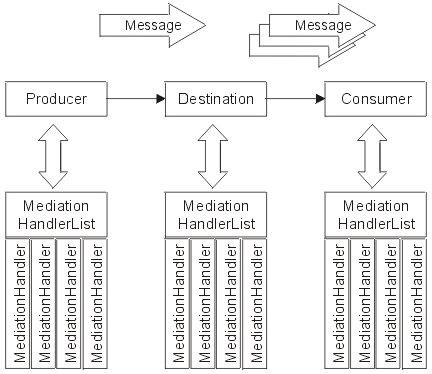Mediation handlers and mediation handler lists
Mediations are specified as a simple sequential list of mediation handlers. We must assemble and deploy the mediation handler list into an Enterprise Applications Archive and install it in WebSphere Application Server. Once the mediation is associated with a destination, it processes messages arriving at that destination. A mediation handler is the Java class that processes the messages.
Examples of message processing performed by a mediation handler include the following:
- Transforming a message into a different format.
- Route messages to other destinations.
- Add data to a message from a data source.
- Modify properties of the message.
The mediation handler class implements the Java interface com.ibm.websphere.sib.mediation.handler.MediationHandler. You assemble the mediation handler class into an Enterprise Applications Archive (EAR) file then deploy the mediation handler application in a mediation handler list by using an assembly tool, for example IBM Rational Application Developer.
We can assign one or more mediation handlers to a mediation handler list to define a set of operations to apply to each message. When we assign a mediation handler to a mediation handler list, we assign a sequence number to the mediation handler. The sequence number is used to determine the specific sequence in which the mediations in the mediation handler lists are invoked.
You configure and create a mediation in the console, attaching it to a destination. By default the mediation handler list has the same name as the mediation handler, but we can specify a different name if required.
Figure 1. Mediation handler lists

Figure 1 shows how a mediation is composed of a simple sequential list of mediation handlers. The result of the operation of each mediation handler in the list determines whether the next mediation handler in the list is called, or if the message is routed to the next destination.
In most cases, you will assign only one mediation handler to a mediation handler list. The tooling used to deploy the mediation handler into an EAR provides a basic configuration option for automatically adding the mediation handler to its own mediation handler list.
The behavior of a mediation handler can be controlled by setting properties at various stages of mediation development. We can set these properties when you write the Java class, assemble and deploy the mediation handler, or at runtime when the mediation is created and installed.
Related concepts
Related tasks
Related information: